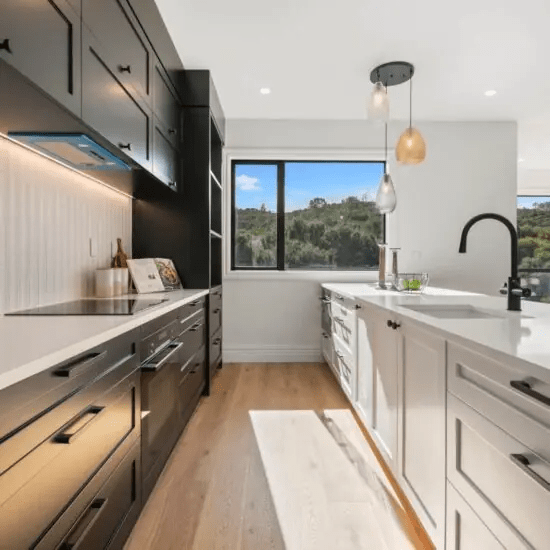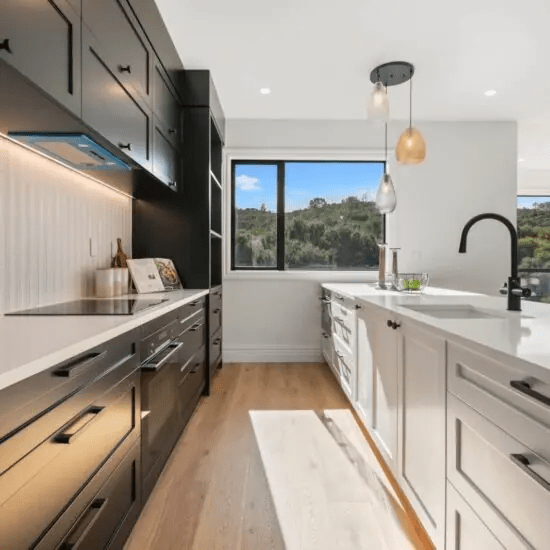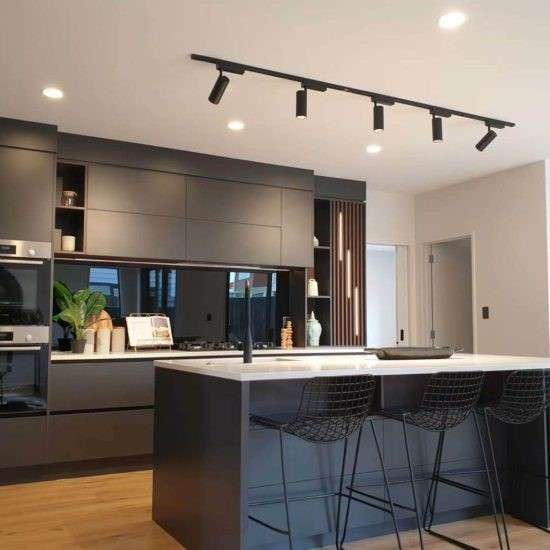
What Space-Saving Ideas Work Best for Small Kitchen Designs in Auckland Homes?
Aucklanders know what it means to make every square metre count, especially in modern urban living. Apartments in the city centre, compact townhouses in Newmarket, and cosy villas in Grey Lynn all need kitchens that work hard without feeling cramped. Good kitchen designs make that happen, drawing inspiration from the efficient use of space and materials, enhancing functionality, especially during a thoughtful renovation. Done well, a small kitchen cooks like a commercial pass, looks calm, and asks almost nothing of you during a busy weekday.
This is where focus pays off. Not more stuff, but smarter choices. Not louder ideas, but clearer ones.
Start with a plan that respects the room
The best small kitchens begin with clear rules.
-Measure circulation. Aim for 900 mm aisle width, 1000 to 1050 mm if you can get it. Any tighter and two people will clash.
-If you’re choosing between an L-shape, a galley, or a straight run with a peninsula, sketch each option to scale. Paper exposes wishful thinking.
-Group tasks into zones rather than forcing a perfect triangle. Prep next to the sink, cooking around the hob, breakfast or drinks near the fridge.
Think through openings. Doors and drawers need breathing space, and fridges love a full swing. Pocket doors on laundries or pantries can free up precious room. Finally, commit to storage depth. Shallow can be better. A 300 mm deep pantry keeps everything visible, which means less waste and fewer double-ups.

Storage that multiplies space
Kilograms live in drawers, not on shelves. Drawers bring things to you, reduce bending, and swallow odd-shaped items with less fuss.
-Base drawers at 450 mm high for pots and small appliances
-A top cutlery drawer at 100 to 150 mm high with dividers
-A mid drawer at 200 mm high for plates and bowls
-Toe-kick drawers for trays and baking sheets
Corners often frustrate. Two good answers: a full-height blind corner pull-out with quality runners, or accept the corner as dead and extend drawers either side. The first protects every centimetre, the second simplifies.
Pull-out pantries are brilliant in tiny footprints. A 300 or 400 mm unit beside the fridge can carry the weekly shop and keep it in easy reach. Internal drawers behind a pantry door are another tidy answer.
Consider these compact helpers:
-Under-sink pull-outs for cleaners and bin systems
-Vertical tray and chopping board slots beside the oven
-A spice pull-out near the hob
-Overhead storage up to the ceiling to stop dust traps
Auckland humidity can be tough on materials. Melamine with laser edge banding and well-sealed edges resists swelling. High-quality cabinetry and hardware from brands like Hafele give smooth action and long life, which matters in a busy kitchen.
Quick glance: ideas that earn their keep
| Space saver | What it does | Best for | Design note |
| Full-extension drawers | Brings contents to you, reduces bending | Base cabinets | Invest in quality runners |
| Pull-out pantry | Slim storage with visibility | Narrow gaps | Keep near fridge or prep zone |
| Toe-kick drawers | Uses dead plinth space | Trays, lids, boards | Needs accurate set-out |
| Blind corner pull-out | Access to the back corner | L or U layouts | Choose sturdy baskets |
| Internal drawers behind doors | Hides clutter, maximises depth | Pantries | Add labels to reduce rummaging |
| Fold-up appliance garage | Keeps bench clear | Coffee and toaster | Vent for heat and steam |
| Magnetic knife strip | Frees a drawer | Small prep areas | Mount away from hob splatter |
Surfaces, colour, and the way light travels
Small kitchens love clean lines, an open-concept design, and a calm palette, reflecting modern aesthetics with thoughtful decor. That doesn’t mean bland. It means controlled.
-Light-toned doors with a gentle texture keep glare down while bouncing light
-Mid-tone timber accents add warmth in a city where winter light can be cool
-A continuous benchtop profile avoids visual noise
Matte finishes hide fingerprints. Satin reflects just enough light to lift the room. Gloss can feel larger but shows marks, so pair it with pull handles to avoid constant touching.
Splashbacks do more than protect walls. Painted glass in a soft grey-green echoes the Waitematā on a still day. White tiles with a pale grout make a tight space feel crisp. Mirrored splashbacks pull the room wide, though they need regular cleaning.
Benchtop thickness matters. A slim 20 mm stone or compact laminate reads lighter than chunky profiles. Waterfall ends can frame a peninsula and protect from knocks, but use them with restraint to keep the room open.
Appliances that pull their weight
Right size is the secret. A 600 mm oven suits most households. A 450 mm dishwasher can be enough in apartments, while a full-size model with a cutlery tray earns its place in family homes.
-Induction hobs heat fast and are easy to clean. Two zones save space, three is often ideal.
-Combination microwave ovens free up space, bake well, and handle weeknight dinners without grabbing bench area.
-Fully integrated fridges keep visual flow. If capacity is tight, an underbench unit with a separate tall pantry can be smarter than a bulky freestanding fridge.
-Choose a quiet rangehood and duct it outside. Recirculating is second best in our humid climate.
Plan power points carefully. One double at either end of the bench plus a hidden socket in an appliance garage handles most countertop tools without clutter.

Layouts that suit Auckland homes
Every home type throws up its own constraints and perks, yet with a touch of inspiration in kitchen designs, even limitations can turn into creative opportunities.
Galley kitchens
Two parallel runs create a tidy work lane. Keep one side for wet prep and the other for cooking. Galley layouts suit apartments where every step is measured. If the aisle falls below 900 mm in a modern design, consider incorporating modern aesthetics and switch some drawers to doors to reduce handle clashes.
L-shape with peninsula
Great in small open-concept open-plan rooms. The peninsula with well-designed cabinetry can host two stools without robbing floor area. Use a waterfall to protect the end, or a rounded corner for softer movement around the edge. Tuck power under the overhang for laptops and homework.
One-wall ace
When there is no room for turns, stack vertically to maximize functionality. Tall pantry, oven tower, then base and wall cabinets with a strong lighting plan. A slim rolling island or a drop-leaf table can double as prep during cooking and disappear later.
Villas and bungalows
Character homes love Shaker profiles in a more refined scale, especially when complemented by thoughtful decor. Use narrower rails, integrated pull handles, and a balanced mix of drawers and doors. Keep the original timber floors visible where possible to maintain that warm Auckland vibe.
Light that works as hard as your appliances
Layered lighting saves shoulders and eyes.
-Task lighting: LED strips or pucks under wall cabinets or shelves at 3000 K to 3500 K for natural colour
-Ambient lighting: a central ceiling light or two flush mounts to even out shadows
-Accent lighting: a soft glow in a glass-fronted cabinet or above a shelf to lift mood
Put everything on dimmers. Early mornings and late nights need softer levels. Ensure the strip lights sit well back to light the bench, not the splashback.
Surprising wins in tiny kitchens
Sometimes the smallest moves land the biggest gains.
-Swap a swinging door for a slider to free a corner
-Standardise drawer widths to keep interiors flexible
-Run cabinets to the ceiling to banish dust and store once-a-year items
-Add a narrow rail for utensils in the prep zone
-Use a fold-down table by a window for occasional dining
Auckland homes can be breezy on one side and still on the other. Ventilation strategy matters. Crack a high window when cooking, size the rangehood correctly, and make room for fresh air.
The craft behind compact magic: Awesome Kitchens
Local expertise counts when you’re shaping a small space in this city. Awesome Kitchens began in 2016 in Penrose and quickly became known for clear design thinking and tidy builds. In 2020, the team moved to Onehunga and opened a two-storey showroom that makes choosing finishes and layouts much easier. Seeing options at full scale reduces the risk of surprises.
What sets the team apart is the way design, manufacturing, and installation sit under one roof. Designers work shoulder to shoulder with cabinetmakers and installers, which keeps details tight and communication quick.
-Deep custom work, tailored to each home and routine
-A skilled, well-tested crew across design, factory, and site
-Advanced German machinery including one of the most capable CNC and edge banding set-ups in New Zealand
-Local materials from trusted names like Hafele and Laminex to keep quality consistent
-A clear, responsive service approach from first chat to the last handle
-Short lead times made possible by streamlined production
Every kitchen leaves the factory with careful edges, accurate drilling, and hardware set to spec. That kind of precision shows in the way drawers glide, doors line up, and panels sit tight to walls that are rarely perfect.
How the process works
Clarity keeps projects calm, on schedule, and smooth during renovation.
1.Conversation and measure: talk through goals, take accurate site measurements, flag any quirks like out-of-plumb walls or tight stairwells
2.Concept design: layouts with 3D views so you can picture movement and storage
3.Materials and appliances: match finishes, hardware, and appliances to your budget and style
4.Final drawings and sign-off: technical documents for the factory and site team
5.Manufacturing: cut, edge, and assemble in-house on advanced machinery
6.Site prep and trades: coordinate with electricians, plumbers, and builders
7.Installation and fit-off: cabinets in, benchtops templated and fitted, doors aligned, hardware adjusted
8.Care guide and check-in: tips for cleaning and a quick review after you’ve cooked a few meals
The team’s in-house installers keep the last mile tidy, which is where many projects stumble.
Three compact Auckland kitchens that punch above their weight
A few recent projects show how small kitchens can carry big loads without crowding a room.
-Newmarket apartment, 55 sqm total: a one-wall kitchen with a 1200 mm peninsula in white satin and light oak cabinetry accents, embodying modern aesthetics. 300 mm pull-out pantry, internal drawers behind a tall door, two-zone induction with a combination oven. Result: 28 percent more storage by volume and a bench that doubles as a study spot.
-Grey Lynn villa, modest lean-to: classic Shaker doors in warm white with a stone-look benchtop, combining timeless decor with practical design. Galley configuration with a deep window ledge as herb space, toe-kick drawers for trays, and a concealed bin under the sink. Result: character kept intact, morning sun bouncing through, and a clear path to the back garden.
-Onehunga unit: L-shape with a compact peninsula, matte green doors with brass pulls, and a mirrored splashback to widen the room. Integrated 450 mm dishwasher, tall pantry with internal drawers, and a quiet ducted rangehood. Result: clutter hidden, light amplified, and a social corner that hosts two stools without blocking the fridge.
Each modern kitchen landed on time thanks to tight coordination between design and the in-house factory. That renovation continuity matters when spaces are tight and measurements unforgiving.
Materials that respect New Zealand living
Salt air near the harbour, winter rain, and busy family use all test finishes. It pays to choose functionality and toughness.
-Moisture-resistant board for carcases with high-quality edge banding
-Durable melamine or 2-pack painted doors based on budget and look
-Stone or high-pressure laminate tops that shrug off daily life
-Drawers with steel sides and full-extension runners, soft close standard
Hinges and runners from Hafele last longer, feel better, and keep alignment. Small kitchens often get opened more times per day because everything is within reach, so dependable hardware is not a luxury.
Budget clarity for small spaces
You can pack a lot of performance into a compact, open-concept footprint without spiralling costs. Ballpark figures in Auckland as a guide, excluding appliances:
| Level | Typical spend | What it often includes |
| Refresh | 12k to 25k | New doors and drawers on existing carcases if suitable, new benchtop, hardware upgrades, new splashback, basic lighting tweak |
| Mid-tier | 25k to 45k | New custom carcases and fronts, full-extension drawers, pull-out pantry, stone top, under-cabinet lighting, ducted rangehood |
| Premium compact | 45k to 80k | Full custom build with internal drawers, integrated appliances, higher-end finishes, feature splashback, detailed lighting plan |
Costs move with layout changes, wall repairs, and appliance choices. Invest first in drawers, hinges, and task lighting, then stretch to finish upgrades. Good bones outlast fashion.
Design details that make daily life easier
Small kitchens shine when details anticipate life’s habits.
-A shallow shelf above the splashback for oils and favourite cups
-Charging drawer with concealed sockets near the fridge
-Rail system for utensils and a paper towel holder to free bench space
-Tall broom cupboard with a pull-out for cleaning gear
-Split bins sized to your council waste routine
If you cook a lot of stir-fries or sear often, give the hob extra splash protection at the sides. If baking is your thing, a rollout for the mixer at hip height reduces lifting.
A showroom built for decisions
Choices feel simpler when you can touch hardware, check finishes in daylight, and open a dozen drawer options before you choose. Awesome Kitchens’ two-storey showroom in Onehunga brings that into one place. Drop by to compare pull-out systems, check tonal differences between whites, and see how a 20 mm stone edge lightens the look compared to thicker profiles.
The team will walk you through layouts on screen, then take you to comparable displays so you can sense scale and reach. That leap between drawing and reality gets smaller when everything is under one roof.
Why homeowners keep picking Awesome Kitchens
-Custom-first mindset that reflects how you cook, shop, and live
-A seasoned team across design, manufacture, and install who share standards and communicate quickly
-Advanced CNC and edge banding that deliver millimetre-accurate parts, clean corners, and strong joins
-Local sourcing from Hafele, Laminex, and other trusted suppliers to keep quality consistent and support New Zealand partners
-Friendly, prompt service with clear timeframes and tidy sites
-Fast turnaround thanks to a streamlined production floor and in-house installers
Since 2016, the team has completed thousands of kitchens across Auckland. That scale has sharpened their eye for small spaces and how to squeeze performance from them without visual clutter.
A checklist to kick off your compact kitchen
-Measure the room, including ceiling height and window placement
-List your five most-used appliances and tools
-Choose a layout that suits your household traffic
-Decide where bins live and how you sort waste
-Pick one hero finish and two supporting players
-Plan for three lighting layers and dimmers
-Prioritise drawers, corner strategy, and a tall pantry
-Confirm power points and charging spots
-Lock in ventilation that actually vents outside
-Visit the showroom to test hardware and finish options
A small kitchen can feel generous and serve as an inspiration when every choice supports the way you live. If you’re ready to see what that looks like in your home, visit Awesome Kitchens in Onehunga or book a chat with the design team. Bring your plans or a quick sketch and a few photos. The first conversation often sparks the smartest idea.
